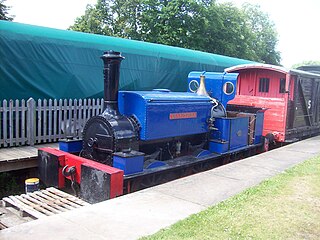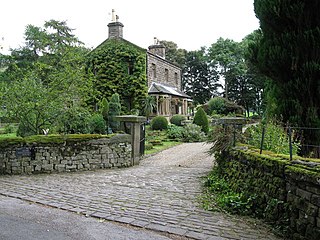Related Research Articles

The North Staffordshire Railway (NSR) was a British railway company formed in 1845 to promote a number of lines in the Staffordshire Potteries and surrounding areas in Staffordshire, Cheshire, Derbyshire and Shropshire.

The Chasewater Railway is a former colliery railway running round the shores of Chasewater in Staffordshire, England. It is now operated as a heritage railway.

The Hunslet Engine Company was founded in 1864 in Hunslet, Leeds, England. The company manufactured steam-powered shunting locomotives for over 100 years, and currently manufactures diesel-engined shunting locomotives.

The Northamptonshire Ironstone Railway Trust operates a 1 1⁄2-mile (2.4 km) long heritage railway line at Hunsbury Hill, south-west of Northampton. The line is mainly dedicated to freight working, featuring many sharp curves and steep gradients which were typical of the industrial railway, but rides are available in a variety of vehicles including a converted brake van.

The Buckley Railway was opened from Buckley to a connection with the Chester to Holyhead main line in 1862, to convey minerals from the Buckley area. Numerous short tramroads had existed in the area for some time. The line was steeply graded and sharply curved.

Crewe Works is a British railway engineering facility, built in 1840 by the Grand Junction Railway. It is located in the town of Crewe, in Cheshire. It is currently owned by Bombardier Transportation.
Wolverhampton railway works was in the city of Wolverhampton in the county of Staffordshire, England. It was almost due north of the city centre, and is commemorated with a small display of level crossing gates and a plaque. Known as the Stafford Road Works, it was opened by the Shrewsbury and Birmingham Railway in 1849 to maintain bought-in locomotives.

Hudswell, Clarke and Company Limited was an engineering and locomotive building company in Jack Lane, Hunslet, Leeds, West Yorkshire, England.

Manning Wardle was a steam locomotive manufacturer based in Hunslet, Leeds, West Yorkshire, England.

Sharp, Stewart and Company was a steam locomotive manufacturer, initially based in Manchester, England. The company was formed in 1843 upon the demise of Sharp, Roberts & Co.. It moved to Glasgow, Scotland in 1888, eventually amalgamating with two other Glasgow-based locomotive manufacturers to form the North British Locomotive Company.

The Garstang and Knot-End Railway [sic] was a railway line, between Garstang and Pilling, in the Fylde of Lancashire. It was built by local agricultural interests to develop unproductive land. It had been intended to continue to Knott End but ran out of money. It eventually opened in 1870. In 1898 the Knott End Railway was authorised to continue to Knott End; it opened in 1908. The two companies were associated and the KER acquired the earlier company. The KER was still desperately short of money, and local people who were owed money bought rolling stock to keep the company going.

Orgreave Colliery was a coal mine situated adjacent to the main line of the Manchester, Sheffield and Lincolnshire Railway about 5 miles (8 km) east of Sheffield and 3.5 miles (6 km) south west of Rotherham. The colliery is within the parish of Orgreave, from which it takes its name.
Waleswood Colliery was a coal mine situated between Swallownest and Wales Bar, near Rotherham, South Yorkshire, England. The colliery was adjacent to the Rotherham to Clowne road and the main line of the Manchester, Sheffield and Lincolnshire Railway about 2 miles east of Woodhouse.

Nidd Valley Light Railway, was a light railway in upper Nidderdale in the West Riding of Yorkshire, England. It was owned by Bradford Corporation Waterworks Department and the Corporation also operated its public passenger services. Power & Traction Ltd of London obtained a Light Railway Order for the 6.5-mile (10.5 km) railway from Pateley Bridge to Lofthouse in 1900, but these powers were taken over by Bradford Corporation. A contract to build Angram Reservoir was awarded to John Best & Son in 1903, and he also won the contract to build the public railway and a 6.5-mile (10.5 km) private extension to the reservoir site. This was initially built to 3 ft gauge but was converted to standard gauge by 1907, when the public railway opened. Best had his own locomotives, and Bradford Corporation equipped the public railway with second hand locomotives and carriages from the Metropolitan Railway.
Blackpool Pleasure Beach Express is a 21 in narrow gauge railway, built in 1933 as a tourist attraction at Pleasure Beach Blackpool, Lancashire.
GWR absorbed locos 1922 on gives details of Great Western Railway absorbed locomotives which do not yet have individual pages.
The North Staffordshire Railway built, or had constructed for it, approximately 350 locomotives. Until the company established Stoke railway works at Stoke-upon-Trent in 1864, a variety of engineering firms supplied locomotives. Increasingly though, the company became more self-reliant and, by the beginning of the 20th century, virtually all new engines were produced at Stoke works.

The South African Railways Dock Shunter 0-4-0ST of 1903 was a steam locomotive from the pre-Union era in the Cape of Good Hope.
References
- Larkin, Edgar J; Larkin, John G (1988). The Railway Workshops of Great Britain 1823-1986. Macmillan Press. ISBN 978-0-333-39431-1.